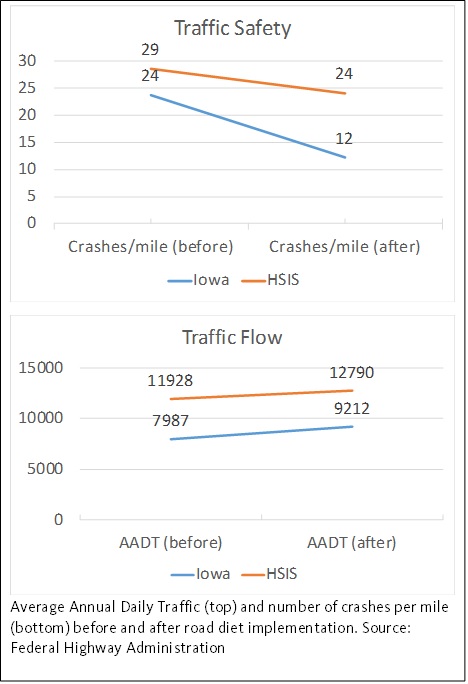Cities around the nation are phasing out their four lane roads (2 lanes in each direction) because they are not safe or efficient. A popular method is the 4-to-3 lane conversion: Replacing two of the travel lanes, one in each direction, with a single center turn lane.
4-to-3 lane conversions reduce crashes and injuries[1], but the idea of removing lanes from a congested road alarms some people. Counter-intuitively, 4-to-3 lane conversion projects carry MORE traffic, despite ‘losing’ a lane[2].

The number of crashes decreases without impairing the number of vehicles after 4-to-3 lane conversions.
The reason 4-to-3 lane conversions reduce crashes and carry more traffic is because of the center turn lane. Without the center turn lane, left-turners block a lane. Drivers are stuck behind the left-turner, waiting for traffic to clear in the right lane so they can go around. With the center turn lane, left turners are out of the way.
Many crashes involve attempts to merge from one lane to another. Reducing the number of vehicles that have to merge reduces the number of crashes. Providing a place for left-turners to wait that doesn’t block a lane allows traffic to flow more freely and efficiently. On a congested road, a 4-to-3 lane conversion actually improves traffic flow! On a lightly traveled road, the conversion has no effect (good or bad) on traffic flow, but does reduce crashes. The conversion paradoxically slows traffic even while carrying more vehicles—the traffic flow is steadier and more consistent, leading to faster travel times with slower speeds and less stop-and-go.
A bonus feature of the 4-to-3 lane conversion is that it frees up space for bicycle lanes, improving the safety of bicyclists as well as drivers. Nearly all 4-to-3 lane conversions include bicycle lanes. The 4-to-3 lane conversion is makes pedestrian crossing safer and easier as well—the middle lane can be used as a ‘refuge’ when crossing the street.
Of course, nothing is free, right? An amazing thing about the 4-to-3 lane conversion is that it is nearly free! Roads are expensive, but paint is cheap. Many 4-to-3 lane conversions happen when a road is due to be resurfaced. The stripes would be repainted anyway, so the conversion costs virtually nothing!
[1] The Federal Highway Administration (FHWA) examined data from 4-to-3 lane conversions at 45 sites in Iowa, California, and Washington and found as much as a 47% reduction in crashes. The effect on safety was lower on roads that did not have as many crashes to start with. Furthermore, the FHWA found that average annual daily traffic increased after the 4-to-3 lane conversions—an indication that traffic flow improved.
[2] 4-to-3 lane conversions are not appropriate for roads that carry more than 20,000 vehicles per day. Examples of 4-lane roads in the Roanoke area that carry less than 20,000 vehicles per day include Williamson Rd in Roanoke, Main St in Salem, and By Pass Rd in Vinton.

